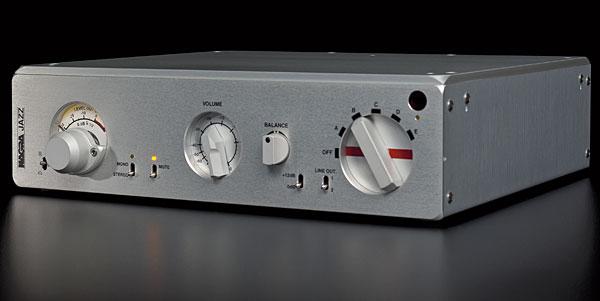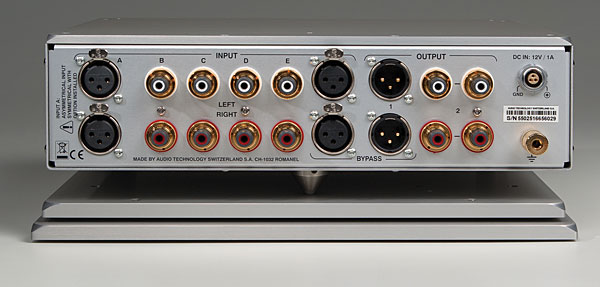| Columns Retired Columns & Blogs |
Marillyn Crispell CD is a nice addition to a jazz collection. Too bad I will never hear it on the Nagra Jazz. A nice looking amp; it's from Switzerland!!

I've heard the occasional Nagra product at audio shows, but infrequently. When I have, I've been in awe of the gorgeous but understated quality of their handmade construction. And the rooms containing Nagra gear always produced superb sound.
My fondest memory of Nagra gear dates back almost a decade. I'd booked a gig for the John Atkinson Trio to perform jazz standards and originals at my local country club in New York City. Our usual drummer, Allen Perkins, of tonearm/turntable maker Immedia, was on the West Coast, so I had to find a drummer to replace him. I called on Mark Flynn, who's now the drummer of my jazz quartet Attention Screen, to sit in. Although Mark and I had long been friends, I'd never heard him play, and took the chance based on his reputation.
It was a warm day, so we set up under an awning next to the outdoor pool. JA asked if it was okay to record the gig; I said, "Sure, why not?" These were the days before the proliferation of Zoom portable digital recorders, and JA had shown up with his Nagra-D open-reel deck and a pair of $2000 DPA microphones. The gig went well and the recording sounded great—but we'd set up midway between the pool and the bar's takeout window. As we played, we were besieged by tweens running from pool to window and back as they loaded up on liquid refreshment, their bodies splashing chlorinated water within inches of the Nagra. I was a nervous wreck for the entire gig.
So when the opportunity arose to hear in my reference system Nagra's Jazz tubed line stage ($12,250), I was, well, jazzed. I promised Nagra I'd keep their baby dry at all times.
Design
As soon as I opened the box, I knew I was in for an interesting experience. The packaging was immaculate, with inner and outer boxes separated by triangular Styrofoam supports. Inside the inner box were the preamp and its ACPS II outboard power supply, each in its own silky sack tied shut with a fabric sash. This packaging made Tiffany seem like Walmart. Although the Jazz and the ACPS II are unbelievably small (respectively, the size of a telephone answering machine and a laptop battery), the preamp's construction is rugged, with a faceplate machined from a solid billet of aluminum. The look, size, and shape are cosmetically identical to those of Nagra's CD players, which are all derived from the company's legendary IV-S portable open-reel deck. I was tempted to pop off the top to see what was inside, but refrained—I didn't want any of my tools to go near the Jazz's gorgeous case.

If I had wandered inside, I would have discovered a 12AX7 dual-triode tube, one per channel configured in differential topology, followed by a gain stage using a 12AT7 tube. The gain can be set to 0dB or 12dB. I tried both and heard no difference. I used the 0dB setting 80% of the time, the +12dB setting the remaining 20%. The Jazz has three groups of four-layered circuit boards of military-grade epoxy glass, gold-plated and festooned with polypropylene capacitors. There circuit boards also a have ground plane, intended to screen out disturbances and radiation, and to stop static loops that might give rise to hum. (Nagra claims an A-weighted signal/noise ratio, ref. 1V, of 105dB.) The ribbon cables linking the boards are as short as possible. The main board is mounted on elastomer blocks to filter out vibrations. The Jazz is also available with the optional VSP, a shock-absorbing double-plate isolation platform ($1950) made of solid aluminum with Alpha-gel feet.
The Jazz's suite of inputs consists of one pair balanced (if the optional input transformers are fitted, otherwise this input is single-ended), four pairs single-ended, and a bypass that routes the inputs directly to the output; the outputs comprise two pairs single-ended and one pair balanced if the optimal output transformers are fitted. On the front panel is an incredibly sexy-looking Modulometer—basically, an output-level meter derived from Nagra's original 1952 tape recorder, the Nagra II, with a red needle for the right channel and a green needle for the left. The modulometer has six levels of illumination (it can also be turned off); I heard no sonic differences among the various levels. The motorized volume, balance, mute, and input selector controls are also accessible via the compact, minimalist, and ergonomically robust remote control. The only incongruity among the otherwise sexy and Swiss-precise front-panel controls is the recessed volume knob, which resembles the heater control on the dashboard of a 1985 Honda Accord.
Listening
As much of my listening for this review occurred during December, I spun some of my favorite Christmas CDs. A Jolly Christmas from Frank Sinatra (CD, Capitol CDP 7 48329 2) is from Sinatra's best period, in my view: the albums he recorded in the 1950s for Capitol. The Nagra's ability to develop an organic and voluptuous uncolored midrange made it a natural match for well-recorded voices. Sinatra's voice in "The First Noel" was warm, open, rich, and vibrant. Although I thought his voice sounded quite natural, the Nagra demonstrated its ability to clearly delineate differences between recordings when I moved to The Doris Day Christmas Album (CD, Columbia 513539 2), a sonic masterpiece. Day's voice in "Silver Bells" was larger than life and startlingly realistic—much more so than Sinatra's. The entire recording was enveloped in an airy, silky sheen of ambience. It was, however, easy to tell that the reverb had been poured on a bit excessively for the Day recording.

Marillyn Crispell CD is a nice addition to a jazz collection. Too bad I will never hear it on the Nagra Jazz. A nice looking amp; it's from Switzerland!!

Hello;
Looks like a very nice component. Nagra gear always makes my heart pump. Great sounding too, going by the review.
I am confused. The review indicates that the input is differential, but later goes on to say that an optional transformer is required for differential. If the amplifier is configured to do balanced (differential), why do we need a transformer to utilze this?
"If I had wandered inside, I would have discovered a 12AX7 dual-triode tube, one per channel configured in differential topology..."
"The Jazz's suite of inputs consists of one pair balanced (if the optional input transformers are fitted, otherwise this input is single-ended)..."
Any explanation?
Thanks
Vince